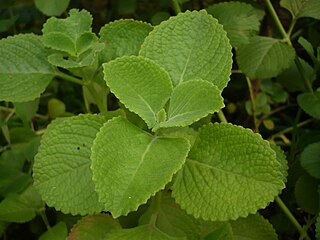
Coleus amboinicus, synonym Plectranthus amboinicus, is a semi-succulent perennial plant in the family Lamiaceae with a pungent oregano-like flavor and odor. Coleus amboinicus is considered to be native to parts of Africa, the Arabian Peninsula, and India, although it is widely cultivated and naturalized elsewhere in the tropics where it is used as a spice and ornamental plant. Common names in English include Indian borage, country borage, French thyme, Indian mint, Mexican mint, Cuban oregano, soup mint, Vicks plant, Spanish thyme. The species epithet, amboinicus refers to Ambon Island, in Indonesia, where it was apparently encountered and described by João de Loureiro (1717–1791).

Coleus rotundifolius, synonyms Plectranthus rotundifolius and Solenostemon rotundifolius, commonly known as native potato or country potato in Africa and called Chinese potato in India, is a perennial herbaceous plant of the mint family (Lamiaceae) native to tropical Africa. It is cultivated for its edible tubers primarily in West Africa, as well as more recently in parts of Asia, especially India, Sri Lanka, Malaysia, and Indonesia.

Plectranthus is a genus of about 85 species of flowering plants from the sage family, Lamiaceae, found mostly in southern and tropical Africa and Madagascar. Common names include spur-flower. Plectranthus species are herbaceous perennial plants, rarely annuals or soft-wooded shrubs, sometimes succulent; sometimes with a tuberous base.

Coleus esculentus, synonym Plectranthus esculentus, also known as the kaffir potato or Livingstone potato, is a species of plant in the dicot family Lamiaceae. It is indigenous to Africa, where it is grown for its edible tubers. It is more difficult to cultivate than Coleus rotundifolius, but able to give greater yields. Although the crop is similar to a potato, it is from the mint family, but it is still quite nutritious and useful. This crop can benefit many subsistence farmers since it is native, easy to grow, enjoying growing popularity in the market, and quite nutritious.

Plectranthus verticillatus, Swedish ivy, Swedish begonia or whorled plectranthus is a plant in the family Lamiaceae (Labiatae), genus Plectranthus. Despite its common name, it is not close to the ivy family of the genus Hedera.

Coleus caninus, synonym Plectranthus caninus, is a herb from the mint family Lamiaceae, native to southern and eastern Africa from Angola to Sudan and to India and Myanmar.

Ctenochaetus, or bristletooth tangs, is a genus of marine ray-finned fish belonging to the family Acanthuridae, which includes the surgeonfishes, unicornfishes and tangs. These fishes are found in the Indo-Pacific region. They have many, small flexible teeth and some species have the common name bristletooth.
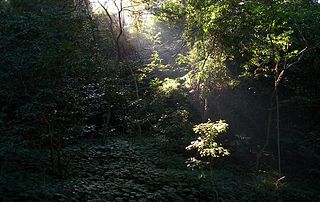
Areas of forest which grow in KwaZulu-Natal, South Africa mostly on south facing slopes in higher rainfall areas, and along the humid coastal areas. Different types of forest can be identified by their species composition which depends mostly on the altitude, latitude and substrate in which they grow. South facing slopes are favourable for the development of forest as they are more shaded, and therefore cooler and retain more moisture than the northern slopes. The extra moisture on the south slopes is not only favoured by forest trees, but also helps to prevent or subdue wildfires. Fires can also be blocked by cliff faces and rocks or boulders on these slopes, and by streams or rivers at the base of the slopes. The coastal regions are conducive to forest formation, because of high rainfall and humidity which are favoured by forest trees and also help to prevent or subdue fires. The rivers of the coastal areas are also broader than further inland, which may often prevent fires from spreading long distances, and fires generally burn uphill and therefore more often away from areas at low altitude.
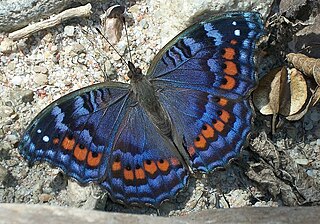
Precis octavia, the gaudy commodore, is a species of butterfly in the family Nymphalidae. It is native to Africa.
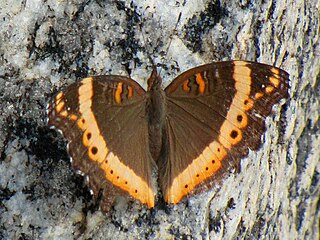
Precis archesia, the garden inspector or garden commodore, is a species of butterfly in the family Nymphalidae, native to Subsaharan Africa.

Coleus is a genus of annual or perennial herbs or shrubs, sometimes succulent, sometimes with a fleshy or tuberous rootstock, found in the Afro-Eurasia tropics and subtropics.

Coleus neochilus, synonym Plectranthus neochilus, which is colloquially known as lobster bush, fly bush or mosquito bush, is a perennial ground cover with highly fragrant, partially scalloped, ovate leaves and purple blue inflorescent spikes.
Equilabium is a genus of flowering plants in the family Lamiaceae. It was split off from the genus Plectranthus in 2018 as the result of a molecular phylogenetic study. Most species are native to Africa, with two found in the Indian subcontinent.
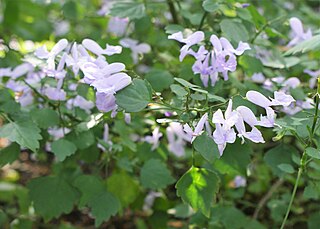
Plectranthus saccatus is a shrub from the mint family Lamiaceae, native to South Africa. The habitat includes forest or shaded situations near the coast.

Plectranthus ecklonii is a shrub from the mint family Lamiaceae, native to South Africa. The habitat includes forest or shaded situations near the coast.

Plectranthus ciliatus, called Indian borage, speckled spur flower, blue spur flower, and candlestick plant, is a species of flowering plant in the family Lamiaceae. It is native to South Africa and Eswatini, and introduced to Victoria in Australia and the North and South Islands of New Zealand. With its Coleus‑like foliage, its cultivar 'Easy Gold' has gained the Royal Horticultural Society's Award of Garden Merit as an ornamental.

Coleus madagascariensis, synonym Plectranthus madagascariensis, called thicket coleus, Madagascar coleus and candle plant, is a species of flowering plant in the family Lamiaceae. It is native to South Africa, eSwatini, Mozambique, Mauritius and Réunion, but not Madagascar. Its cultivar 'Variegated Mintleaf' has gained the Royal Horticultural Society's Award of Garden Merit.
Plectranthus ambiguus, the pincushion spurflower, is a species of flowering plant in the family Lamiaceae, native to the Eastern Cape and Kwazulu-Natal provinces of South Africa. Its cultivar 'Manguzuku' has gained the Royal Horticultural Society's Award of Garden Merit. Flowers are pinkish purple with faint purple lines on the upper edge.
Deer Reserve National Park is a nature reserve in the Somerset Region of Queensland, in the South East Queensland bioregion. The name "Deer Reserve" refers to a gift of red deer to the Cressbrook Station. Plants protected in Deer Reserve National Park and the adjoining Deer Reserve State Forest include Plectranthus leiperi. It covers an area of 32.3 square kilometers. It is located 480 meters above sea level.















